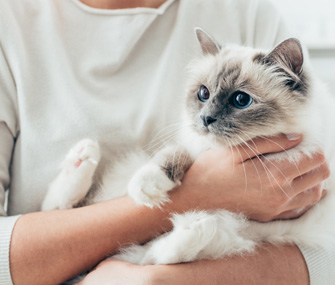Why Doesn’t My Cat… Like To Be Held?
Published on January 06, 2017

Veterinarians get a lot of questions about pets, and not all of them are about health. Often, pet owners ask about seemingly random behaviors. Cat lovers, in particular, typically want to get a better handle on their felines — sometimes literally: They want to know why their particular cat doesn’t enjoy being held.
We’ve all experienced the squirming cat at one time or another. You pick him up, and instantly you have an armful of furry whirling wrath as he attempts to get four on the floor. What’s his problem? I have some thoughts of my own about why cats resist cuddling, and I asked my colleague Dr. Wailani Sung, a board-certified veterinary behaviorist, to weigh in as well.
Why Your Cat Won’t Cuddle
Most cats enjoy being up high because they have a better view of their territory, but in many cases they want to achieve those heights on their own terms. It’s one thing for a cat to jump up on the kitchen counter or a bookcase, but being held by a person may seem demeaning to one who is a relative — albeit a tiny one — of the king of beasts. If your cat doesn’t enjoy being held, it may be because he just feels disrespected when you scoop him up.
Other cats may have a related reason for resisting restraint — and, let’s face it, being picked up and held is a form of restraint, even if it’s meant lovingly. Dr. Sung says some cats have had negative experiences with being restrained. “This could be associated with being physically restrained for vaccinations, having their temperature taken or having their nails trimmed,” she says. “There are still some clinics that scruff cats and kittens for any veterinary procedure. It takes only one to two mildly negative experiences to teach a cat to be wary.”
[object Object]
It’s Not Natural
There’s also the fact that being held just isn’t a normal interaction between cats — they don’t pick each other up and cuddle. Instead, cats show affection to other felines by approaching politely, sniffing, licking and rubbing each other. Being picked up can send a different signal to a cat than the one intended by your friendly overtures.
In fact, your cat may see your efforts to hold him as an attack. “The cat may perceive being restrained as ‘I’m trapped!’ or ‘Something bad is going to happen to me!’ or ‘I’m about to be killed or eaten!’” Dr. Sung says. “Remember that cats are predators to smaller prey but are themselves prey to larger predators.” No wonder your cat struggles to get away!
This isn’t true in every case, though. I always like to remind people that cats are individuals. Some love to be cuddled — think Ragdolls and Ragamuffins, who are known for flopping back comfortably when held. But not even all of those cats live up to their “ragdoll” reputation. Dr. Sung recommends being sensitive to your cat’s preferences. If you force affection on him, he can become more reluctant to interact with you.
“The cat may become less tolerant and avoid the owner, struggle after a brief moment or even exhibit aggressive behavior toward owners when they try to pick them up,” she says.
Most important, pay attention to changes in your cat’s behavior. If he normally loves to be held and snuggled, take note if he suddenly resists being held. He could have a painful medical problem that’s causing the unusual behavior. Take him to your veterinarian for a once-over to make sure he has a clean bill of health.
More on Vetstreet:

